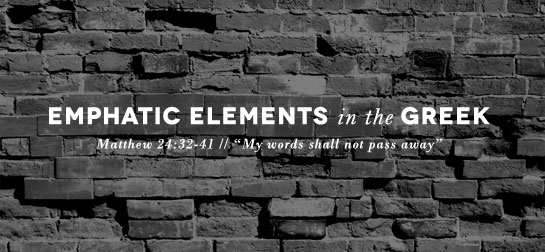
Justin Alfred, a Biblical language expert, has been walking us through “emphatic negations” in Biblical Greek. Emphatic negations are an explicitly strong way to express a negative. While a normal negative might mean “that will not happen,” an emphatic negative further tells the reader that there is not even the slightest possibility that something will occur.
To illustrate the use of emphatic negations, Justin began a blog series on the emphatic elements found in Matthew 24. This incredible series concluded last week, so just in case you missed it, here is a list of each post:
- Section I on Matthew 24:1-3.
“…even though Titus attempted to stop his soldiers from burning and completely destroying the Temple, he failed to do so, and thus, Jesus’ Words, totally apart from his cognizance, were completely fulfilled in Matthew 24:2: ‘And He answered and said to them, ‘Do you not see all these things? Truly I say to you, not one stone here shall be left upon another, which will not be torn down.'” - Section II on Matthew 24:4-8.
“…what Jesus was talking about in this section will continue until He returns, which includes not only false teachers and teachings (e.g. the Jehovah’s Witnesses as well), but also a continuation of wars, famines, earthquakes, plagues, etc.” - Section III on Matthew 24:9-14.
“In this section, Jesus talks about the persecution that His followers will endure until He returns, as well as the fact that ‘many’ of His professed followers ‘will fall away and will deliver up one another and hate one another.'” - Section IV on Matthew 24:15-28.
“This passage is clearly talking about something that will be a sign of the soon return of Jesus, and that has to do with the ‘abomination of desolation’ that is going to be once again erected in the ‘holy place.’ I say once again, because this first occurred in December, 167 BC, under the Seleucid King, Antiochus Epiphanes. - Section V on Matthew 24:29-31.
“According to the eschatological chronology given prior to this passage, this is unequivocally referring to the period of time ‘immediately after the great tribulation’ that we see being described in Daniel and Revelation covering a seven or three and one-half year time period, depending upon whether one adopts a pre or mid-tribulation rapture position…” - Section VI on Matthew 24:32-35.
“We are now at the core of this whole passage with regard to the subjunctive of emphatic negation. Jesus is saying emphatically that neither ‘this generation’ will in NO WAY WHATSOEVER ‘pass away until all these things take place,’ and even though ‘heaven and earth will pass away,’ His ‘words shall in NO WAY AT ANY TIME EVER ‘pass away.'” - Section VII on Matthew 24:36-41.
“What all of this means is that one’s past actions have become so enmeshed into the present result, that the present result is the ultimate reality and the unalterable, state of being of repeated, past actions. Consequently, because of God’s sovereign purpose and plan, even ‘before the foundation of the world’ (Ephesians 1:3-6), His ultimate actions and purposes are at times far beyond our seriously flawed, human ability to comprehend, grasp, and understand, which UNEQUIVOCALLY INCLUDES THE RETURN OF CHRIST!”
Thank you, Justin, for taking the time to walk us through the emphatic elements found in Matthew 24.